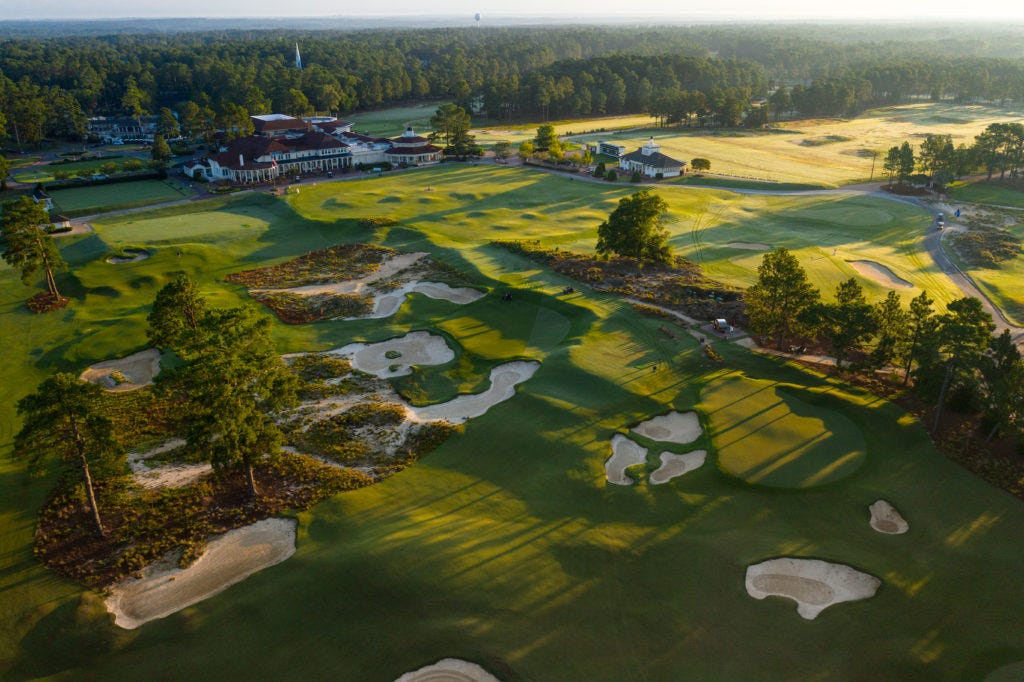When someone gets into a new thing - be it a sport, cooking, or really any hobby, there’s a natural progression to the interest/obsession.
First, you just are excited to do it - you know you’re not great at it so just trying to get better is what you want to spend time at.
Next, you start seeing some progress and you start realizing your gear isn’t what it should be. Maybe you had a starter set in golf, or you need a better pan or Dutch Oven to cook with, etc.
Then, you start getting adventurous - maybe you want to play from a set of tees that’s farther back, or try playing some courses you were maybe afraid to before. In cooking, maybe this is trying a really tricky recipe, or cooking for a lot of folks.
And so forth. And with any such hobby, you can really get into the weeds. And one such “weed” with golf is architecture. There are a lot of famous names in Golf Course Architecture (GCA, as it’s informally known) and people like Andy Johnson of The Fried Egg have carved out a career in being a formal voice of expertise about GCA.
Some folks get into GCA in terms of “template holes,” and pore over yardage guides and such. That’s a subject for another discussion but for me, after being lucky enough to play a lot of golf courses, I’ve started forming stronger opinions about which architects I’m really excited about, and therefore which courses I might want to play in the future.
Fair warning - some uninformed takes will be coming.
First off - one designer I don’t think much of is arguably the greatest golfer of all time. Jack Nicklaus just doesn’t make golf courses I like. (And to be as fair as possible, many “Nicklaus” designs have little more than his name on it, but in theory represent his design principles.) All of Nicklaus’ courses LOOK pretty - there are waterfalls everywhere and lots of great flora. But they’re not that interesting. And they’re often fairly penalizing.
Now, I shot my greatest round ever at Pronghorn (Nicklaus) but even I have to admit it’s not really that great of a course. I just had it going that day.
I’ve talked a bit about Pete Dye and probably will come back to him at some other point.
There are so many good golf architects and many others that don’t have the name brand of the bigger names but are doing really cool things (or did in the past). I made a list here, then realized about ten guys I left off and instead I won’t even attempt a comprehensive list.
It’s also worth noting that these architects can do really three different things.
Create a new golf course that is purely their design. That’s what I’ll largely be focusing on here.
Renovate a course - perhaps taking a course with good bones but an outdated design and changing it up to make it more interesting, more relevant to todays’ game and technology, etc.
Restoration - this can happen when a designer comes in to bring a course BACK to what it once was. Gil Hanse just did this at Lake Merced CC, for example after Rees Jones did a renovation to the original MacKenzie design. Here is a startling tweet showing the difference:
The larger picture is the original design. The upper right is the Rees Jones “renovation” where he flattened EVERYTHING out. Hanse restores it to much closer to the original design in the lower right hand corner.
I know which one I like, and that’s as good a segue as any to say that this will focus on Gil Hanse.
So, we know Hanse is really good at restoration - he’s been hired to do similar work at some other phenomenal golf courses. But he has his own designs as well, and I’ve been fortunate enough to play a few:
Rustic Canyon, Moorpark, CA
Streamsong (Black), Bowling Green, FL
The Cradle Short Course, Pinehurst, NC
Castle Stuart, Inverness, Scotland
In addition, the renovation work he did at Pinehurst No. 4 was so good it’s one of my favorite courses I’ve ever played. His work at Soule Park helped turn a tired old course into one of the best values in golf.
This summer, I’ll be adding Narin & Portnoo in Ireland to this list, and hope of course to add several others in due time. I have enjoyed all the courses above, and they’re ranked highly in my personal list of courses I’ve played. What is interesting to me is … I don’t know how much they have in common.
Streamsong (Black) is most famous for massive, undulating greens that flow seamlessly into the fairway, instead of having the typical “collar” you see on most greens. Rustic Canyon (and Soule Park) both share a similar “false front” approach to the greens where from the fairway you think the green starts at a certain point … but that’s actually NOT the green which is set further back. With Castle Stuart and Rustic Canyon, Hanse credits co-designers (Mark Parsinen and Geoff Shackleford, respectively) but even still, it’s hard to work around one of his courses and say, “OH, right, this is a Gil Hanse.” And that’s intentional:
Our designs will not become repetitive. Every golf course site is unique and different; our designs reflect that individuality.
On a Pete Dye course, you’re GONNA find railroad ties and massive water hazards. On a Jack Nicklaus course, you’re probably going to find a waterfall and narrow fairways. But on a Gil Hanse course, you’re going to find … a course that fits the land it’s on. A few more bullets from their “Philosophy” section of their website:
Traditional golf courses focus first and foremost on the player and his or her experiences on the course.
We create courses that are simple and elegant in appearance, yet sophisticated in strategy and design.
I don’t want to be TOO much of a golf dork, but this speaks to me. Standing on a tee box with a giant fairway ahead of you may lead many golfers to just grip it and rip it - but if you take a step back and look at what lies ahead, maybe glance at the yardage book or talk to your caddie if you have one, you’ll realize there’s definitely a better side of the fairway to land on to prepare you for your second shot. Look at the first sentence quoted above and compare that to the Pete Dye/Jack Nicklaus ethos of golf not being about fun, but as a challenge. Both perspectives are true, but on the whole, I’m definitely going to enjoy a round on a Gil Hanse more than the other two.
If anything, Hanse and his company are held back because they are SO good at restoration (just check out the names on this website of the courses they’ve restored and/or are restoring; it’s jaw-dropping if you know golf at all). Perhaps that’s truly Hanse’s passion, but I’ll just say it wouldn’t bother me if he created a few new courses on his own - because I’m a fan.












